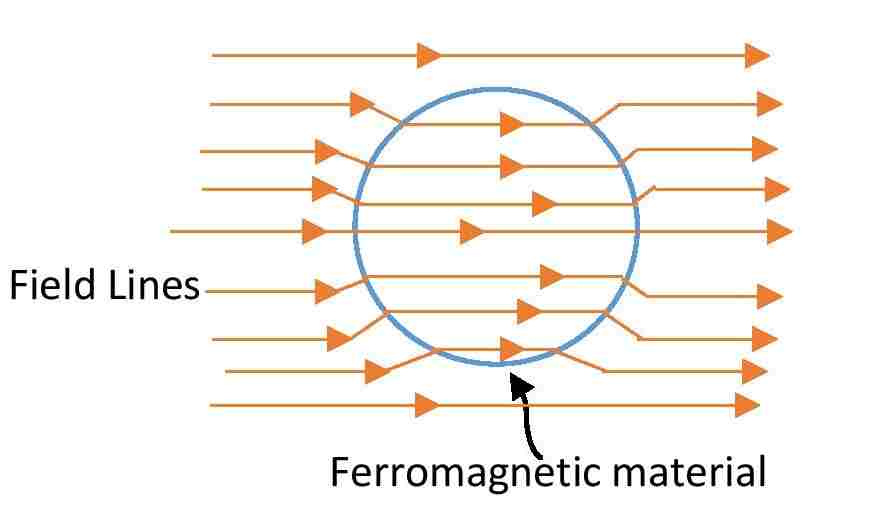Most of the materials are affected by the magnetic field. These materials are magnetic materials. These materials can show magnetic properties. The origin of magnetic moment in these materials is the rotation of orbital electrons around the nucleus. On the basis of the magnetic properties of materials, there are five types of magnetic materials – Diamagnetic materials, Paramagnetic materials, Ferromagnetic materials, Ferrimagnetic materials and anti-ferromagnetic materials. In this article, we are going to discuss the origin, properties and examples of ferromagnetic materials.
Contents in this article:
- What are ferromagnetic materials?
- Example of ferromagnetic material
- Origin of ferromagnetism
- Properties of ferromagnetic material
- Uses of ferromagnetic material
What are ferromagnetic materials?
A ferromagnetic material is a type of material that is attracted strongly by an external magnetic field. One can convert a ferromagnetic material like an iron rod, or steel into a permanent magnet by the process of magnetic induction. This type of material can retain the induced magnetism even after removing the external magnetic field.
Examples of ferromagnetic materials
Iron (Fe), Nickel (Ni), Cobalt (Co), Gadolinium (Gd) and some alloys like steel etc. are the most common 5 examples of ferromagnetic materials. If someone asks you for examples of magnetic materials, you should give examples of ferromagnetic materials. This type of magnetic material has a significant amount of magnetic properties.
Origin of ferromagnetism
Ferromagnetic materials have high magnetization. Such a high value of magnetization is not only due to the spin of electrons. There is something else. This can be explained by domain theory.
Scientists think that Ferromagnetic materials have a large number of domains inside them. All the atomic dipoles in a domain have the same orientations but the dipole moments of different domains have different orientations. Therefore, the net dipole moment is non-zero for each domain individually. But the net dipole moment of the entire material becomes zero as the overall dipole moment of all domains cancels each other. In the diagram, there are four domains and the orange-colored arrows represent the dipole moments in each domain.

Now, if the material is placed in an external magnetizing field, dipoles of all domains try to orient in the direction of the applied magnetic field. At this, the resultant dipole moment becomes very high. Hence, its magnetic property appears which is much stronger than the diamagnetic property. On increasing the strength of the magnetizing field, ferromagnetic material becomes more magnetized. But after a certain limit, it reaches to the saturation level where the magnetization of ferromagnetic material will not increase even after increasing the external field.
Properties of ferromagnetic materials

Here is the list of some properties of ferromagnetic materials –
- Attracted strongly by the magnet.
- Magnetic field lines are denser inside this material when it is in an external magnetic field.
- Relative magnetic permeability is very high (in the order of 102 to 106).
- Magnetic susceptibility is much greater than unity.
- Ferromagnetic material shows hysteresis property.
- This type of material can retain the magnetic property even after removing the external magnetic field. So, one can use a ferromagnetic material as a permanent magnet after the magnetic induction.
- After a certain temperature, Ferromagnetic materials behave like paramagnetic materials. This critical temperature is Curie’s temperature.
Uses of ferromagnetic material
- Ferromagnetic material is used in the core of a transformer.
- One can convert this type of material into a permanent magnet.
- Ferromagnetic materials are also used in dynamos and motors.
Some Important questions on ferromagnetic material
1. What is Curie’s temperature?
Ans: Curie temperature is the critical temperature of a ferromagnetic material above which it behaves like a paramagnetic material.
2. What is the value of relative permeability in ferromagnetic material?
Ans: Relative magnetic permeability for a ferromagnetic material is very high and usually it has a value in the order of 102 to 106.
This is all from this article on properties and examples of ferromagnetic materials. If you have any doubt on this topic you can ask me in the comment section.
Thank you!
Related posts:
1 thought on “Ferromagnetic materials – examples, origin & properties”
Comments are closed.